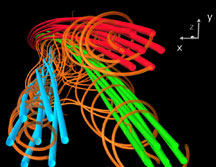Magnetic Flux Ropes

PIC method
| Plasma Physics | |
| Prof. Walter Gekelman Magnetic Flux Ropes |
|
 |
|
| This will be an experimental study of magnetic flux ropes. Flux ropes are helical magnetic fields with pitch varying with radius. They emanate from the surface of the sun and rise above it as giant arches. Sometime they are abruptly ejected and become CME ʼ s (coronal mass ejections). If we are unlucky they can hit the earth and interrupt the local electrical power grid or destroy satellites in earth orbit. We have been studying these objects for the past few years and the study will continue this summer. One way of “seeing them” is through the acquisition of data sets where magnetic field data, for example, is acquired at tens of thousands of positions in the experimental device and at thousands of time steps. Below is an image of the magnetic field of three flux ropes and the currents associated with them. The magnetic fields are colored red,green and blue and the plasma currents are orange-yellow. The Distance along the z axis is 9 meters (also the direction of the background magnetic field) and the the transverse x-y plane is 24 cm on a side. This summer we will study the production of flux ropes from a narrow sheet of current. The current sheet can spontaneously tear into a number of ropes that will interact with one another. The work will entail construction of the current source using a specialized high emittance cathode and the acquisition and analysis of data. If interested you can learn to use the visualization tool used to make the image above. The work will be done on the the Large Plasma Device at UCLA (the LAPD). You can check out our website at http://plasma.physics.ucla.edu/bapsf | |
| Prof. Warren Mori and Viktor Decyk PIC method |
|
| The particle-in-cell (PIC) method is widely used in plasma physics and accelerator and beam physics. It is also used in cosmology and semi-classical quantum mechanics. This method attempts to model plasmas at the most fundamental level, by integrating the individual trajectories of simulation particles. At a given time, the particle's charge (or mass), position, and momenta are used to calculate the charge (or mass density) and/or current density onto a grid (cell). These sources are used to calculate fields ( for example, electromagnetic or gravitational) based on appropriate physical field equations (e.g, Maxwell's equations) that are solved for at the cell locations.. The fields are used to calculate forces on the particles and the equations of motion for each particle is used to "push" particles to new positions and momentum and the loop is repeated the desired number of time steps. PIC models are approximations of reality which can contain numerical artifacts whose consequences must be understood, such as the use of finite-sized particles. Within the UCLA simulation of plasmas group, we have many different PIC codes. Some of these codes have been run on the largest computers in the world and some run on a single desktop. We use these codes to study many fundamental problems in plasma physics, including inertial confinement fusion, plasma based acceleration, and collisionless shock generation and propagation. There are two view points for the physical interpretation of the particle-in-cell method. The first is that PIC models the Klimontovich equation for finite size particles. The second view point is that PIC attempts to model the Vlasov equation. Surprisingly, even after near half a century of use, there are still differences of opinion regarding which viewpoint should be used when asking if the method is mathematically correct. During this summer, you will learn about both the Klimontovich and Vlasov equation, about the PIC method, and about some of the research done within the Simulation of Plasma Group. You will run some of our PIC codes and study how results converge and how dispersion relations of fundamental plasma waves change as numerical parameters are varied. These studies will shed light on how the relative merit of each view point with respect to how to test the mathematical correctness of the PIC method. | |